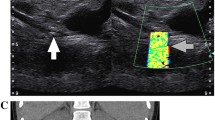Abstract
Objective
To detail the utility of CT scan in detection of urinary stones induced by melamine tainted formula.
Material and Methods
A total of 1062 children fed with melamine-contaminated infant formula were screened for urinary stones in our institute from September through December 2008. Ultrasonography of the urinary tract system was performed in all these children. If the children with suspected stones or severe obstruction were presented after ultrasound examination, the multi-detector row CT urographic examination was advocated subsequently.
Results
Ultrasound examination in combination with multi-detector row CT urography could increase the diagnostic rate from 3.4% (36/1062) by ultrasound examination alone to 4.6% (49/1062).
Conclusions
The specificity and sensitivity of the multi-detector row CT urographic examination is higher than ultrasonography.


Similar content being viewed by others
References
Chen JS. A worldwide food safety concern in 2008—melamine-contaminated infant formula in China caused urinary tract stone in 290, 000 children in China. Chin Med J (Engl). 2009;122:243–4.
Chen JS. What can we learn from the 2008 melamine crisis in China? Biomed Environ Sci. 2009;22:109–11.
Bhalla V, Grimm PC, Chertow GM, Pao AC. Melamine nephrotoxicity: an emerging epidemic in an era of globalization. Kidney Int. 2009;75:774–9.
Hon KL. Melamine-tainted milk: when China sneezes, Hong Kong catches cold. Indian J Pediatr. 2010;77:109–10.
Sun N, Shen Y, Sun Q, Li XR, Jia LQ, Zhang GJ, et al. Diagnosis and treatment of melamine-associated urinary calculus complicated with acute renal failure in infants and young children. Chin Med J (Engl). 2009;122:245–51.
Chiu MC. Melamine-tainted milk product (MTMP) renal stone outbreak in humans. Hong Kong Med J. 2008;14:424–6.
Caoili EM, Cohan RH, Korobkin M, Platt JF, Francis IR, Faerber GJ, et al. Urinary tract abnormalities: initial experience with multi-detector row CT urography. Radiology. 2002;222:353–60.
Caoili EM, Inampudi P, Cohan RH, Ellis JH. Optimization of multi-detector row CT urography: effect of compression, saline administration, and prolongation of acquisition delay. Radiology. 2005;235:116–23.
Brown CA, Jeong KS, Poppenga RH, Puschner B, Miller DM, Ellis AE, et al. Outbreaks of renal failure associated with melamine and cyanuric acid in dogs and cats in 2004 and 2007. J Vet Diagn Invest. 2007;19:525–31.
Ogasawara H, Imaida K, Ishiwata H, Toyoda K, Kawanishi T, Uneyama C, et al. Urinary bladder carcinogenesis induced by melamine in F344 male rats: correlation between carcinogenicity and urolith formation. Carcinogenesis. 1995;16:2773–7.
Jia XD, Li N, Wang ZT, Zhao YF, Wu YN, Yan WX. Assessment on dietary melamine exposure from tainted infant formula. Biomed Environ Sci. 2009;22:100–3.
Langman CB, Alon U, Ingelfinger J, Englund M, Saland JM, Somers MJ, et al. A position statement on kidney disease from powdered infant formula-based melamine exposure in Chinese infants. Pediatr Nephrol. 2009;24:1263–6.
Zhu SL, Li JH, Chen L, Bao ZX, Zhang LJ, Li JP, et al. Conservative management of pediatric nephrolithiasis caused by melamine-contaminated milk powder. Pediatrics. 2009;123:e1099–102.
Guan N, Fan Q, Ding J, Zhao Y, Lu J, Ai Y, et al. Melamine-contaminated powdered formula and urolithiasis in young children. N Engl J Med. 2009;360:1067–74.
Hoppe B, Kemper MJ. Diagnostic examination of the child with urolithiasis or nephrocalcinosis. Pediatr Nephrol. 2010;25:403–13.
He Y, Jiang GP, Zhao L, Qian JJ, Yang XZ, Li XY, et al. Ultrasonographic characteristics of urolithiasis in children exposed to melamine-tainted powdered formula. World J Pediatr. 2009;5:118–21.
Kawashima A, Vrtiska TJ, LeRoy AJ, Hartman RP, McCollough CH, King Jr BF. CT urography. Radiographics. 2004;24:S35–54.
Joffe SA, Servaes S, Okon S, Horowitz M. Multi-detector row CT urography in the evaluation of hematuria. Radiographics. 2003;23:1441–55.
Ren FY, Wang Y, Hou XB, Zhang CR, Ma L. Clinical and imaging features in 16 infants exposed to food contaminated with melamine and cyanuric acid. AJR Am J Roentgenol. 2009;192:707–10.
Brenner DJ, Hall EJ. Computed tomography—an increasing source of radiation exposure. N Engl J Med. 2007;357:2277–84.
Verdun FR, Gutierrez D, Vader JP, Aroua A, Alamo-Maestre LT, Bochud F, et al. CT radiation dose in children: a survey to establish age-based diagnostic reference levels in Switzerland. Eur Radiol. 2008;18:1980–6.
Author information
Authors and Affiliations
Corresponding author
Rights and permissions
About this article
Cite this article
Hu, P., Lu, L., Qin, Y.H. et al. Utility of CT Scan in Detection of Melamine - Associated Urinary Stones. Indian J Pediatr 77, 1405–1408 (2010). https://doi.org/10.1007/s12098-010-0183-1
Received:
Accepted:
Published:
Issue Date:
DOI: https://doi.org/10.1007/s12098-010-0183-1




